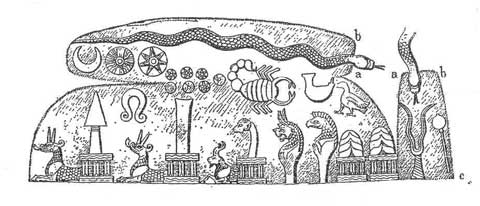Berossus and a Sibyl
“Since these fragments do not express Babylonian astronomical or astrological doctrines, the obvious conclusion is that their attribution to Berossos is not genuine. In a way, this astronomical / astrological material can be compared with the work which Annius of Viterbo fabricated under the name of Berosus Chaldaeus.
Since these fragments are not genuine, I assume that the testimonies describing Berossos as an ‘internationally’ renowned astrologer are also fabricated. The creation of a ‘Berossos the astrologer’ is not a unique case in Greek and Roman literature. The aforementioned Egyptians, pharaoh Nechepso and his sage Petosiris, under whose names several works circulated, are merely Hellenistic creations.
Likewise, the life of the famous philosopher Pythagoras was quickly surrounded by legends: he travelled across the Orient and was taught by native sages. A Roman tradition even held that he taught the Roman king Numa Pompilius, who is traditionally dated some 150 years before the historical Pythagoras, at the end of the 8th c. BC.
The character of ‘Berossos the astrologer’ was very likely created in order to give astronomical / astrological doctrines a Babylonian origin. The story of his school on Cos might have been invented in order to explain how ‘Chaldaean’ lore reached the Greek world.
For later generations Berossos the historian and the astrologer were obviously one and the same person. This explains why Josephus mentions Berossos’ role in transmitting Babylonian astronomical and philosophical lore and continues by paraphrasing and citing from his history (BNJ 680 T 3, F 8a and F 9a).
The reason why Berossos was chosen to become an astrologer is easy to find: he was a ‘Chaldaean’, a Babylonian priest himself, for Greeks and Romans great experts in astronomy and astrology. Moreover, he had written a history based on arcane native sources.
Some testimonies, finally, report that Berossos was the father of the Hebrew-Babylonian Sibyl called Sabbe (BNJT 7a-c, In the Suda this Sibyl is called “Sambethe,” Σ 361 s.v. Chaldaean Sibyl). This is undoubtedly a legend.
Its origin may be connected to the insertion of a story ascribed to the Sibyl in the epitome which Alexander Polyhistor made of Berossos’ work (BNJ 680 F4a-b). That Sibyl too can very likely be identified as the Hebrew-Babylonian one. The inserted paraphrase in Polyhistor’s epitome derives from the Third Sibylline Book, which implies that the Sibyl in Polyhistor is the same as the pseudepigraphic Sibylline author of this book.
The latter can be labelled as ‘Hebrew-Babylonian’, as she is said to be a relative of Noah and to have dwelt in Babylon after the Flood. Berossos’ fatherhood of a prophetess might also be related, in one way or another, with Pliny’s testimony that he made divine predictions (BNJ 680 T 6).”
Geert de Breucker, “Berossos: His Life and Work,” from Johannes Haubold, Giovanni B. Lanfranchi, Robert Rollinger, John Steele (eds.), The World of Berossos, Proceedings of the 4th International Colloquium on the Ancient Near East Between Classical and Ancient Oriental Traditions, Harrassowitz Verlag, Wiesbaden, 2013, p. 20.

